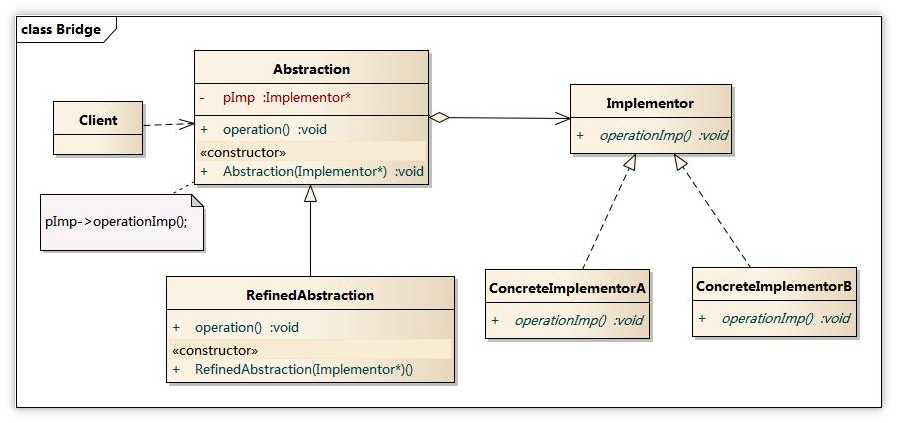 设计模式-桥接模式
设计模式-桥接模式
# 设计模式-桥接模式
# 概述
现在有毛笔和画笔两种笔,如果我们需要绘画出12种颜色,那么对于画笔我们需要12支不同颜色的笔,而对于毛笔则需要另外12种颜色调料。再来如果我们还要区分笔的大小(大、中、小),那么要绘出12种不同大小的颜色,画笔就需要36支,而毛笔在这样的需求之下,只需要额外加两种不同型号的毛笔就可以。
如果使用软件工程中的术语,可以认为在画笔中颜色和型号存在较强的耦合性,而毛笔很好地将两者解耦,使用起来非常灵活,扩展也更为方便。
# 定义
如果系统中的某个类存在两个独立变化的维度,通过桥接模式可以将这两个维度分离出来,使两者可以独立扩展。
**桥接模式:**将抽象部分与它的实现部分解耦,使得两者都能够独立变化。
# 桥接模式结构

桥接模式包含以下四个角色:
1、Abstraction(抽象类):用于定义抽象类的接口,通常是抽象类而不是接口。
2、RefinedAbstraction(扩充抽象类):扩充Abstraction定义的接口。
3、Implementor (实现类接口):定义实现类的接口。
4、ConcreteImplementor(具体实现类):具体实现Implementor接口。
# 桥接模式应用实例
1、创建画圆的接口:
public interface DrawApi {
public void drawCircle(int radius, int x, int y);
}
2、创建接口的两个实现类:
public class GreenCircle implements DrawApi {
@Override
public void drawCircle(int radius, int x, int y) {
System.out.println("Drawing Circle[ color: green, radius: "
+ radius + ", x: " + x + ", " + y + "]");
}
}
public class RedCircle implements DrawApi {
@Override
public void drawCircle(int radius, int x, int y) {
System.out.println("Drawing Circle[ color: red, radius: "
+ radius + ", x: " + x + ", " + y + "]");
}
}
3、创建抽象图形类
public abstract class Shape {
protected DrawApi drawApi;
protected Shape(DrawApi drawApi) {
this.drawApi = drawApi;
}
public abstract void draw();
}
4、创建圆类
public class Circle extends Shape {
private final int x;
private final int y;
private final int radius;
public Circle(int x, int y, int radius, DrawApi drawApi) {
super(drawApi);
this.x = x;
this.y = y;
this.radius = radius;
}
public void draw() {
drawApi.drawCircle(radius, x, y);
}
}
5、案例实现
public class Main {
public static void main(String[] args) {
Shape redCircle = new Circle(100, 100, 10, new RedCircle());
Shape greenCircle = new Circle(100, 100, 10, new GreenCircle());
redCircle.draw();
greenCircle.draw();
}
}
# 桥接模式优缺点
优点:
1、分离抽象接口及其实现部分。·
2、取代多层继承方案。
3、优秀的扩展能力,提高了系统的可扩展性,在两个变化维度中任意扩展一个维度都不需要修改原有系统。
缺点:
1、桥接模式的使用会增加系统的理解与设计难度,由于关联关系建立在抽象层,要求开发者一开始就针对抽象层进行设计与编程。
2、要求正确地识别出系统中地两个独立变化的维度。
# 桥接模式适用环境
1、如果一个系统需要在构件的抽象化角色和具体化角色之间增加更多的灵活性,避免在两个层次之间建立静态的继承联系,通过桥接模式可以使它们在抽象层建立一个关联关系。
2、对于那些不希望使用继承或因为多层次继承导致系统类的个数急剧增加的系统,桥接模式尤为适用。
3、一个类存在两个独立变化的维度,且这两个维度都需要进行扩展。
# 参考
Java设计模式
